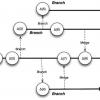|
Thoughts from Mid-Project My team is in the middle of one of the hardest projects—we call them "themes"—we’ve ever tackled. We’re a high-functioning agile team that has helped our company grow and succeed over several years now—we “went agile” in 2003. Here’s one thing I know for sure: No matter how many problems you solve, new challenges will pop up. |
||
|
How to Resolve Disputes So Everyone Wins It's a special skill to be able to terminate disputes amicably. In this week's column, Naomi Karten offers suggestions for how to resolve disputes so that none of the parties suffers from black eyes or bruised egos. |
||
|
|
Software Project Estimation Tired of guesstimating your estimation process just to create a completion date management will accept? Jonathan Kohl takes the guess work out of estimations by focusing on uncertainties. It may sound counterintuitive, but the idea is to focus on the fact that all projects face unforeseen delays. The rigorous estimation process Jonathan describes here provides your team a way that ensures enough time is scheduled for development and a date for completion management can agree upon. |
|
|
Four Frequent Feedback-Gathering Flaws Giving your customers the opportunity to provide feedback is great, but only if you don't fall into one of the four traps that Naomi Karten describes in this article. Let your customers know that not only do you want their feedback, but that you'll actually use the important info they give you. |
||
|
Large-Scale Distributed Agile Teams – Creating, Sizing, Prioritizing and Grooming the Product Backlog Teams that work in large-scale, complex agile environments are often distributed. As a result, it is almost impossible to discuss distributed agile development without discussing the implications of working at scale. In this article, we will cover the following topics to help distributed, large-scale teams create their initial product backlog at the start of a project: |
||
|
How to Align Your Team with the Scrum Model A successful Scrum implementation requires proper understanding of Scrum processes within team and within all project stakeholders. Even after proper training and certification (CSM/CSPO) it’s really tough to achieve the success as intended. There is one common and important problem which has always been overlooked: the alignment of current team with Scrum the model. Because, vanilla-Scrum only describe what the role does in the process. |
Vinay Krishna
November 9, 2010 |
|
|
Agile Adoption Roadmap There continues to be a lot of debate on whether Agile is mainstream. According to a Forrester report published in early 2010, while widespread “Agile” use of the iterative software development processes is found, " teams are not adopting scrum, extreme programming, or another specific Agile approach, but are embracing agile as an ethos or philosophy and cherry-picking the best bits from many different process models to develop a formula unique to their own situation." However, the largest category in the survey – and the one that is the most telling is that 30.6% of the respondents said they do not use a formal process methodology. Add to this my own experience implementing Agile, reading the latest Agile literature (e.g., articles, research, books, etc.), and discussing Agile (and Agile implementations) with people across numerous companies in North America, Europe, and Asia, and what this indicates to me is that: |
||
|
Agile is the Mainstream. So What? The Quest for Quality We have seen software development evolve from ad hoc to CMMI, to Unified Process, to Agile, to Lean, to what next. Why the evolution? Agile has become the mainstream software development method today. So what? What have we been missing? What are we searching for? In my opinion, it is the quest and delivery of a high quality product. We should strive for quality being non-negotiable. Build something without an emphasis on quality and you are building on a poor foundation that will eventually lead to collapse and result in a final product with little to no commercial or operational value. |
||
 |
End-of-Release Branching Strategies This two-part article explores branching strategies—development tactics that allow teams to work concurrently on different features and maintain the relationship between them. In part one, Steve Berczuk explains what branches are, common types of them, and the tradeoffs between branching styles. |
|
|
Distributed Multi-Source Development What are leading development organizations doing to increase innovation, agility and embrace new technologies? The answer: Distributed multi-source development Large software projects that are late. Missed schedules. Budget over-runs. These aren’t pleasant challenges to manage, yet they are hallmarks of traditional waterfall software development methodologies. This common approach to creating software is yielding to two powerful approaches to development: distributed development using Agile methodologies, and multi-source development, combining closed source with free and open source components. |
Pages
Upcoming Events
| Jun 02 |
AI Con USA Bridging Minds and Machines |
| Sep 22 |
STARWEST Software Testing Conference in Anaheim & Online |
| Oct 13 |
Agile + DevOps USA The Conference for Agile and DevOps Professionals |








